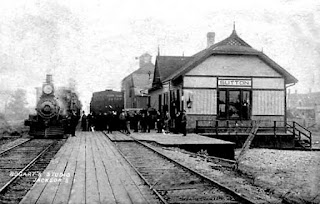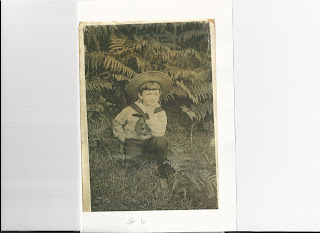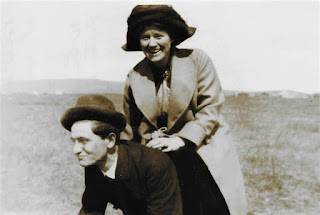History of Lorna
Tremayne and Edmund Grant
by Gwenyth C. Noble (nee
Grant) -
with additions by Lorna
Harris and Ed Grant's writings
made May 15, 2009 and January 22 ff, 2023 and Dec. 4, 2024
Lorna Anne Emily Tremayne was born on June 6, 1887. The only girl in a family of four children, her parents were Agnes Pearson Ritchie Tremayne and Francis Geddes (F. G.) Tremayne. Canon William Ritchie and Anne Sibbald (daughter of Susan Sibbald) were her mother Agnes’s parents. Lorna’s paternal grandfather was Rev. Francis Tremayne who married Emily Jane Kelly Geddes.
F.G. Tremayne was a pharmacist and the family lived at Dryden Bank (40 River Rd., Sutton West, Ontario). He had stores in Sutton and Keswick, and the family spent summer time at Sibbald’s Point. Lorna was educated in Toronto at Ryerson Technical School in sewing patterns and designing clothes. She lived on Chicora Ave. during that time. (Gwen lived on the same street at number 17 from 1942 to 1946). Lorna and her brothers saw the first Eaton’s Santa Clause parade at Hogg’s Hollow about 1912.
Her parents wanted Lorna to marry her
cousin, Charles Sibbald (?), who was considerably older than she was. However,
she met Edmund Grant at St. James Church in Sutton when they were both about 20
years of age. Ed had come to the Sutton
West area from Wales when he was 17 years of age (in March 1906).
 |
| Sutton West, Ontario: Grand Trunk RR Station 1906 |
Edmund Graff Nichols Grant was born April 28th 1887 just outside Cardiff in Llantrisant Wales (at 1 Brook St.), the last of 13 children born to Duncan Joseph Grant (1835-1916), and Margaret Jones (1842-1896).
 |
| Duncan Joseph Grant |
 |
| Children of Duncan Grant and Margaret Jones c. 1888 |
 |
| Margaret Jones |
Nicholls was a family name being his paternal grandmother’s surname (Caroline M. Nicholls 1796-1883, who was married to John Grant 1797 -1848). Graff or Graf was apparently the name of a family friend. It does not appear in the family tree anywhere. In a letter to Gwenyth Noble, Ed’s brother Jim said he looked high and low for a connection even to phoning all the Grafs and Graffs in the Calgary phone book at the time (c. 1977) and concluded the name was German and that was all he was able to conclude. For that matter, Edmund is not a family name in the tree so where it came from is a bit of a mystery too, but it is a Welsh name… so maybe from the Jones family?
 |
| Edmund Grant as a boy in Wales, photo likely by his father |
According to Gwenyth, Ed’s father couldn’t cope and he went to live with his
daughter Louise Heard. Ed, who had been
living his father and his second wife, had been sent to live with his Aunt
Jessica Escott (her husband Jim was a school teacher and a rather “rough man”). His sisters Caroline (a nurse) and Margaret
(a seamstress), who were both employed, paid for his education. He studied Greek and Latin and was headed
toward an academic career. In his reminiscences for the family, Ed Grant
writes, “I attended Albany Rd.. Board School and Howard Gardens Higher Grade
School. I served three years with the firm of A.& Y. Taylor, Duke St.,
Cardiff, S. Wales and learned the photographic and picture framing business.”
 |
| The Lake Manitoba |
He worked on a farmed owned by a Mr. John. Kay at the recommendation of a friend in Cardiff. It was in Virginia, south of Sutton West. He stayed there for two years then went to the Macdonald farm less than a mile from Sutton. He was young energetic and always busy, as they worked very long days.
Ed got to know the rector of the Anglican church and was invited to sing in the choir. There he met Lorna Tremayne and they soon became “fast friends.”
 |
| Wedding Day May 14, 1913 |
They then moved to Calgary. Due to WWI, business was poor once men went to war, but Ed always found a job. Ed was not accepted into the armed forces because of varicose veins in his legs — these he had all of his life and were about the size of one’s thumb.

Davenport Alberta 1913: The motorbike is not in the picture!
Lorna lost her first baby in 1914. Their second, Agnes, was delivered by an RCMP officer on March 2, 1915.
 |
| Lorna Tremayne Grant with Agnes Margaret Grant in Calgary 1915 |
On January 18, 1917, Francis Duncan was born. By this time, although they had some good neighbours in Airdre, they were too isolated and gave up homesteading and lived in a comfortable house in Calgary where Ed drove a milk truck. There are pictures of the house(s) in the photo album, taken years later about 1960. Lorna’s parents came to visit once together, and her father came at least twice.

Grandpa Tremayne with Lorna Grant, Francis, Gwenyth and Agnes (Bow River, Calgary c.1920)
Then calls for help came from Lorna’s
parents. Lorna had done all the care and
housekeeping while she waited to marry Ed, and her parents were not used to
being with a paid housekeeper – these latter were very poor workers. Lorna came back twice to help when her mother
was not well, bringing first one, then two children with her. She and Ed returned for her mother’s funeral
in 1917 (she is buried in Sutton). They
left all their belongings in the homestead.
Nothing was ever disturbed although travellers used the shelter, as was
the custom. The strangers always
replenished the fuel and the water.
The little family departed amid huge crowds. Agnes remembered her mother saying “You and Frances hold my skirt and I will carry the baby and the suitcase.” The men in charge said, “Make way for the women and children,” at the top of their voices, so Agnes remembered. Finally safe in Calgary, Gwenyth and her father met for the first time.
The fourth trip back to Ontario in 1922 proved to be a permanent move from Calgary. By this time there were four children, Geddes Llewelyn having been born in 1920. Four trips east had taken a toll on their savings, but they did have enough wherewithal to travel first class. I believe on this trip, they took a steamer through the Great Lakes. One of the children fell on the deck and hurt himself and Mum remembers a crew member mopping up the blood – nose bleed?
Lorna took over housekeeping for her father and she and Ed worked at his pharmacy. Ed took training in theology from Rev. Mr. Bouskill in preparation for entering Trinity College for formal theological training at the University of Toronto. The three older children attended school in Sutton and church at St. James. Gwenyth remembers it as a nice time. In 1924, the school burned down. Gwenyth attended the empty ice cream parlour for classes and sat at a little iron table and chairs. Agnes and Francis were in the church hall.
Lorna’s brother John attended the Engineering Faculty at University of Toronto. Another brother, Francis Ritchie Tremayne, had died at age 16 of pernicious anemia.
 |
| Lorna Tremayne with brothers Francis, John, and Maurice in Sutton West |
Ed and Lorna moved to Toronto where they took over a large rooming house at 43 Avenue Rd. for one year. Then they moved to 30 Tranby Ave., while Ed completed his theology degree at U. of T. (The house sold in 2007 for $850,000!) According to his daughter Gwen, he had a splendid voice, won the music prize and also the prize for Greek studies. (Lorna was also musical; she played the violin and later taught music to church choir members). The children attended Jesse Ketchum P.S., where Mr. Kirk was the principal. Edmund Ogilvie, the youngest child, was born in 1926.

Grant children at Westport 1929 (L to R Geddes, Gwenyth, Frances, and Agnes with Ogilvie in front)
In 1929, after he was priested by Bishop
Seager, the family moved to Westport and Ed had the church there and in Bedford
Mills (in the Diocese of Ontario). The
town of Westport was very pretty – about 35 miles from Kingston – on the Rideau
Lake and on Sand Lake on the west end – very good for swimming. The family had a great outdoor life,
vegetable garden in the summer, some meals from parishioners in lieu of funds,
as the depression was very severe. Lorna’s brother John and family came to
visit, as did Maurice’s.
The children all had a good education. Agnes had her high school diploma and her ATCM accreditation form the Royal Conservatory of Music in Toronto. Francis had a diploma as a wireless operator and served in the Merchant Navy in WWII, as his health would not allow him into the regular navy. Geddes took tool and die training at Harbord Collegiate in Toronto and then went into the Air Force. Ogilvie enlisted in the Air Force in 1944. Gwenyth became a Registered Nurse and took a post-grad in Obstetrics, as well as receiving her bachelor’s degree in nursing from the University of Toronto Faculty of Nursing, specializing in public health nursing. She worked at Prince Edward County Hospital in Picton, Ottawa Civic Hospital, Women’s College Hospital and the VON in Toronto. Later, beginning in 1960, she worked at St. Joseph’s Hospital in London, Ontario and for the City of London department of public health.
Gwenyth recalls, “We had a great life. We had nothing much given of a material nature, but we had caring parents and a wonderful education.”
%20,%20Agnes,%20Ged,%20Gwen%20enlarged.jpg) |
| Bancroft: the five Grant children |
%20(1).jpg) |
| March 9, 1930 Westport: Gwenyth snowshoes |
 |
| Tyn-y-Maes Maitland, Ontario |
.jpg) |
| 50th wedding anniversary Maitland |
Their children and grandchildren visited them frequently; Edmund and Lorna also had many friends. Lorna suffered diabetes after age 76, but it was controlled by insulin. She lived to be 89 years of age.
Ed suffered memory loss due to senile
dementia and lived for two years at the Island Park Lodge in Ottawa. He died at age 92. Ed was an energetic, cheerful, unselfish kind
man. He was well liked by all his
friends and congregations. He and Lorna
worked tirelessly for the church. Lorna organized concerts and pantomimes in
which the children performed.
































